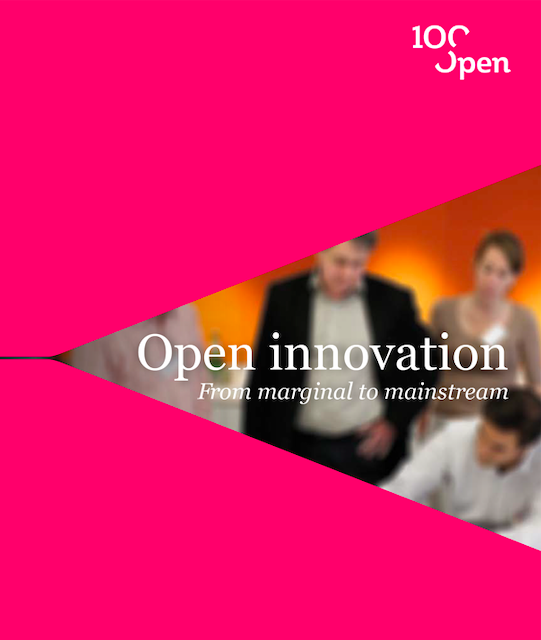100%Open Past and Future
A Reflection on 10 Years in Open Innovation.
Marginal to mainstream
When 100%Open was spun out of Nesta 10 years ago, open innovation was interesting. Interesting – in a marginal, quirky, alternative, slightly hippy way. Interesting – as one of those challenger strategies that would never really rock the boat. Of course, proprietary innovation is the lifeblood of large companies. A company’s value largely rests on its ability to create and protect intellectual property, doesn’t it? The answer, it turns out quite often, is no.

The major shift from 2009 to today is that most large organisations have embraced open innovation as mainstream within their innovation, partnering and investment activities. Many, if not most, large organisations now have a Head of Open Innovation in some guise and have adopted venturing, challenges, technology search or partnering as core skills. Each organisation is developing a capability in open innovation within an overall portfolio – after all open innovation isn’t the only show in town.
The business case for open innovation
Why is this? Open innovation gets large organisations better innovations, faster and cheaper than doing it in house. Better because they’re outside of the corporate box, faster because the R&D has already been done and cheaper because its efficient and can side-step corporate processes. In many projects we’ve worked on, an unexpected bonus is the effect on corporate culture. It turns out that company staff like the involvement with the outside world and this has the effect of opening up the culture internally too.
The development of open innovation
Open innovation has not developed at the same pace in different sectors. Early adopters were in pharma, aerospace and IT – businesses whose lifeblood is innovation. Then came Fast Moving Consumer Goods (FMCG), financial services, food & drink, electronics, the built environment, and transportation.
To take one sector as an example, financial services illustrates the potential of open innovation to go beyond product innovation into a whole new world of radically different business models that are redefining the meaning of banking brands. 100%Open facilitated the recent Open Innovation in Banking conference in Paris a few weeks back. It was surprising and gratifying how many European banks are creating new relationships with suppliers and customers and as a consequence, reexamining their role. We heard how Santander intends to become a platform for other services – a major shift in what it means to be a bank. Equally interesting was the move towards open banking itself, often in collaboration with the regulators which is reassuring from a user perspective too. The fintech explosion has not only given banks faster, cheaper and better innovations, it has helped them embrace new cultures of user-centricity, agile development and service design. Our own UBS Future of Finance challenges have tracked these changes from 2015, enabling the bank to profit from new networks, partnerships and profile.

In the transport sector, Our Autumn Union explored open data and digital mobility. Should transport companies be compelled to open up timetable, fares and location data? Should the sector get together to create the business case for being more open? These are major questions that go beyond new products and services.
In the energy sector, we attended the launch of a new Innovate UK call ‘Modernising Energy Data Access’, exploring the use of open data in energy systems in order to accelerate the UK’s decarbonisation. It’s fascinating just how impactful exchanging digital energy information could be in building a new industry that delivers new consumer-friendly energy services.
What’s next in open innovation
It is great to see so much good open innovation going on. There are over 300 digital brokerage companies in 2019 and significant consultancies in most global markets. Our 100%Open Innovation Toolkit has had tens of thousands of downloads and it has been satisfying for us to influence the agenda and set some standards in open innovation practice.
As open innovation reaches maturity, it’s clear to see that the focus has shifted from the skills to mindsets. Many companies are now equipped to to build new external networks, create successful challenges and find exciting new technologies. But do they contain collaborative and empathetic mindsets? Do they have the the most compelling business models? 100%Open is increasingly paying attention to helping open innovations land in organisations; reprogramming the corporate antibodies and creating a fair Give-Get for everyone involved. If you’d like to rate your own organisation’s progress, just take our Open Organisation Test and see how you fare.
What’s next for 100%Open?
In light of this reflection of the state-of-the-art of open innovation we’ve come up with a new vision for the next ten years:
- Our intention: We aim to help create more open, transparent and therefore trusted organisations
- The intention of our intention: 100%Open believes in openness, connectedness and mutual dependency
- The intention of our intention of our intention: We want to transform. An open approach is better for the well-being of staff and users and better for society and the environment
Come and help us take openness to the next level. The open innovation sector has moved from marginal to mainstream. The next phase is to move it to mission.
It would be great to add new connections to the hundreds that have already helped us achieve what we have. We thank all our past clients, associates and partners and look forward to meeting many more.
David Simoes-Brown